In pond aquaculture, do not apply more nutrients and organic matter in fertilizer and feed than can be assimilated
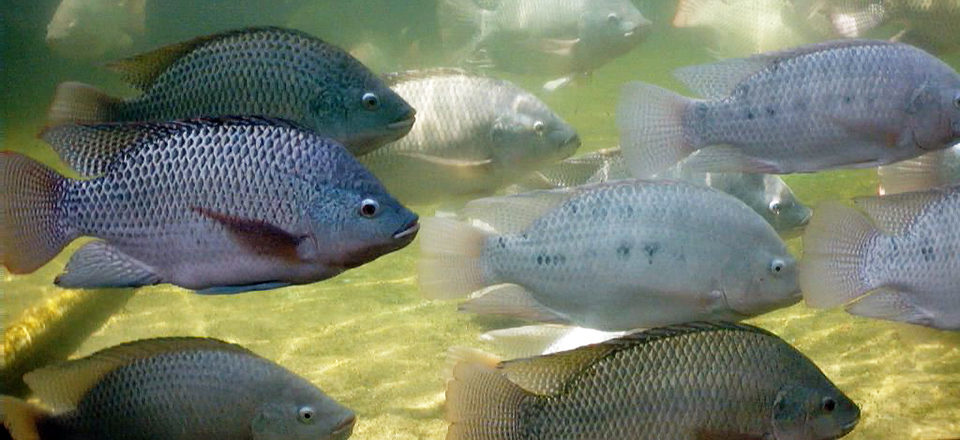
Aquatic organisms absorb molecular oxygen from water and use it to oxidize organic compounds and release energy for doing biological work. In the process called respiration, they also must expel carbon dioxide, the resulting waste.
Fish blood contains the pigment hemoglobin, which combines with molecular oxygen and allows blood to absorb much more oxygen than will dissolve in the hemolymph (blood fluids). Shrimp and other crustaceans have the pigment hemocyanin, which differs from hemoglobin in containing copper rather than iron. The loading and unloading of hemoglobin and hemocyanin with oxygen are controlled by dissolved-oxygen tension in water and hemolymph.
Oxygen tension
Oxygen tension refers to the pressure of dissolved oxygen in water. Water saturated with dissolved oxygen has an oxygen tension of about 160 mm Hg – the partial pressure of oxygen in the atmosphere. The concentration of oxygen at saturation varies with water temperature (Table 1), but the tension of oxygen-saturated water remains the same. For the purpose of loading hemoglobin with oxygen, there is no difference in water at 20 degrees-C and 9.07 mg/L dissolved oxygen and water at 30 degrees-C with 8.30 mg/L dissolved oxygen.
Boyd, Solubility of oxygen in freshwater at different temperatures, Table 1
| Temperature (° C) | Dissolved Oxygen (mg/L) | Temperature (° C) | Dissolved Oxygen (mg/L) |
|---|---|---|---|
| 0 | 14.60 | 21 | 8.90 |
| 1 | 14.20 | 22 | 8.73 |
| 2 | 13.81 | 23 | 8.56 |
| 3 | 13.44 | 24 | 8.40 |
| 4 | 13.09 | 25 | 8.24 |
| 5 | 12.76 | 26 | 8.09 |
| 6 | 12.44 | 27 | 7.95 |
| 7 | 12.13 | 28 | 7.81 |
| 8 | 11.83 | 29 | 7.67 |
| 9 | 11.55 | 30 | 7.54 |
| 10 | 11.28 | 31 | 7.41 |
| 11 | 11.02 | 32 | 7.29 |
| 12 | 10.77 | 33 | 7.17 |
| 13 | 10.52 | 34 | 7.05 |
| 14 | 10.29 | 35 | 6.93 |
| 15 | 10.07 | 36 | 6.82 |
| 16 | 9.86 | 37 | 6.72 |
| 17 | 9.65 | 38 | 6.61 |
| 18 | 9.45 | 39 | 6.51 |
| 19 | 9.26 | 40 | 6.41 |
| 20 | 9.08 |
Oxygen tension in water typically is higher than in the blood entering an aquatic animal’s gills from the venous system. Oxygen dissolves in the hemolymph and loads onto the hemoglobin. In the tissues of an aquatic animal, oxygen is used rapidly, and tissue fluids have a lower oxygen tension than oxygenated, arterial blood from the gills. Thus, hemoglobin unloads oxygen to the tissue fluids.
The relationship between oxygen tension and the percentage saturation of hemoglobin is called the oxyhemoglobin dissociation curve (Fig. 1). The shape of the oxyhemoglobin dissociation curve is usually sigmoid for warm-water species and hyperbolic for cold-water species.
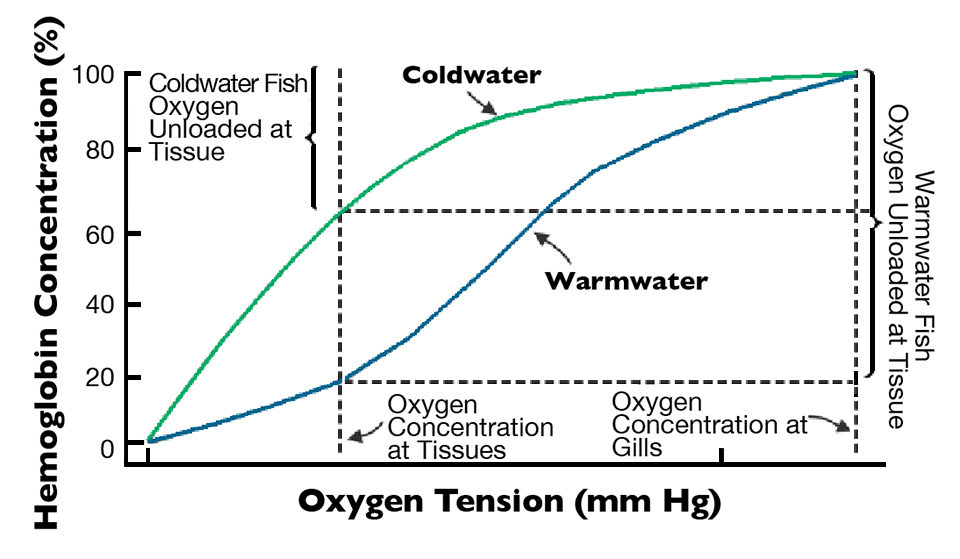
As a result, warmwater species have a greater capacity than coldwater species to unload oxygen at the tissues. This is a major reason for the requirement of coldwater species for a higher dissolved-oxygen concentration than needed by warmwater species.
Carbon dioxide
Carbon dioxide released during respiration by tissue cells dissolves in tissue fluids and is transported by venous blood to the gills. Water usually has a lower carbon dioxide concentration than that in the blood in the gills, and carbon dioxide diffuses into the water.
A high carbon dioxide concentration in water interferes with the diffusion of carbon dioxide from the blood to water. High carbon dioxide in the blood depresses blood pH and has many negative physiological consequences. High carbon dioxide levels also interfere with the loading of hemoglobin with oxygen.
As carbon dioxide concentration increases, higher dissolved-oxygen tension is necessary to load hemoglobin with oxygen (Fig. 2). Thus, a high carbon dioxide concentration at a time when dissolved-oxygen concentration is low is particularly undesirable.
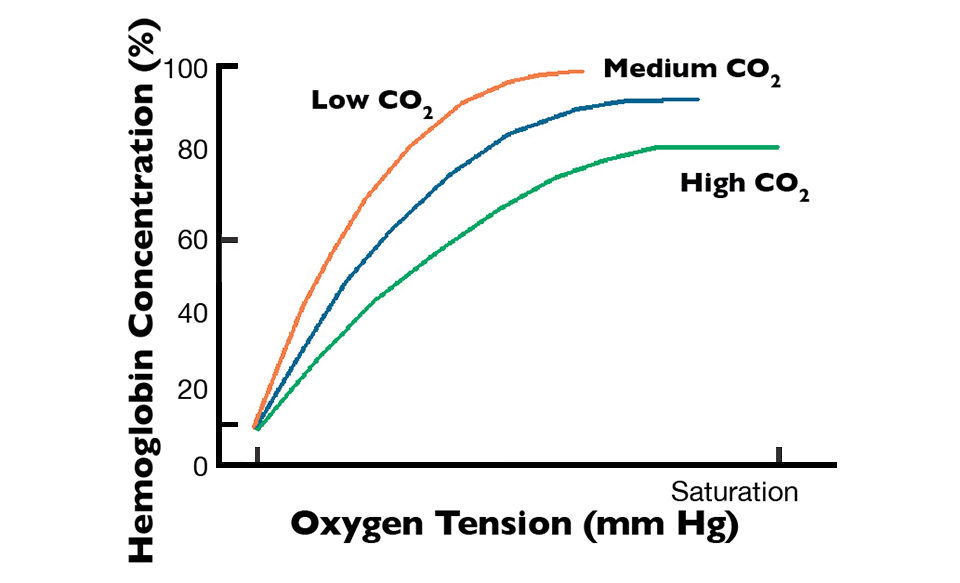
Carbon dioxide is not highly toxic to fish and other aquatic animals, but in experimental units, they avoided concentrations of 10 mg/L or greater. Most species tolerate up to 60 mg/L or more of carbon dioxide if there is plenty of dissolved oxygen. High carbon dioxide concentrations do, however, have a narcotic effect on fish.
Oxygen use
The amount of oxygen used by aquatic animals varies with species, size, temperature, time since feeding, degree of physical activity and other factors. Average oxygen consumption rates for adult fish usually are between 200 and 500 mg oxygen/kg fish/hour.
Assuming an oxygen consumption rate of 350 mg/kg/hour in a 1-ha pond with 1 m average depth, each ton of fish would use an amount of dissolved oxygen equal to 0.84 mg/L in 24 hours. However, small fish use much more oxygen than large fish – 10-gram channel catfish were reported to use 1,050 mg oxygen/kg fish/hour, while 500-gram fish used only 480 mg oxygen/kg fish/hour. One hour after feeding, channel catfish consumed 680 mg oxygen/kg/hour, but after fasting overnight, the hourly rate dropped to 380 mg/kg.
Tilapia forced to swim against a 60-cm/second current consumed oxygen twice as fast as those swimming against a 30-cm/second current. Oxygen consumption is also strongly dependent upon temperature – the rate roughly doubles with a 10 degrees-C increase in temperature within the temperature tolerance of the species. Although less data are available on oxygen consumption by crustaceans, it appears that shrimp consume oxygen at rates similar to those of fish.
Perspectives
In pond aquaculture, the main precaution to avoid low dissolved-oxygen concentrations is to not apply more nutrients and organic matter in fertilizer and feed than can be assimilated, but this depends upon the amount of aeration used. Normally, aeration should be provided at about 1 hp for each 400 to 500 kg of production, but dissolved-oxygen concentration should be monitored – especially between midnight and dawn – to confirm adequate aeration.
Warm-water fish usually survive at dissolved-oxygen concentrations as low as 1.0 m/L, while cold-water fish normally survive at 2.5 to 3.5 mg/L dissolved oxygen. However, fish and other aquatic animals are stressed, susceptible to diseases and grow slowly at low dissolved-oxygen concentrations.
As a general rule, dissolved-oxygen concentrations in culture systems should not be allowed to fall below 50 percent of saturation (about 80 mm Hg). In freshwater at sea level, 50 percent saturation is around 5 mg/L at 15 degrees-C and 4 mg/L at 26 degrees-C (Table 1).
Carbon dioxide is removed from water by aeration, but in an emergency where fish are stressed by low dissolved-oxygen concentration, lime can be applied at 25 to 50 kg/ha to lower carbon dioxide concentration.
(Editor’s Note: This article was originally published in the November/December 2011 print edition of the Global Aquaculture Advocate.)
Author
-

Claude E. Boyd, Ph.D.
Department of Fisheries and Allied Aquacultures
Auburn University
Auburn, Alabama 36849 USA[117,100,101,46,110,114,117,98,117,97,64,49,101,99,100,121,111,98]
Related Posts
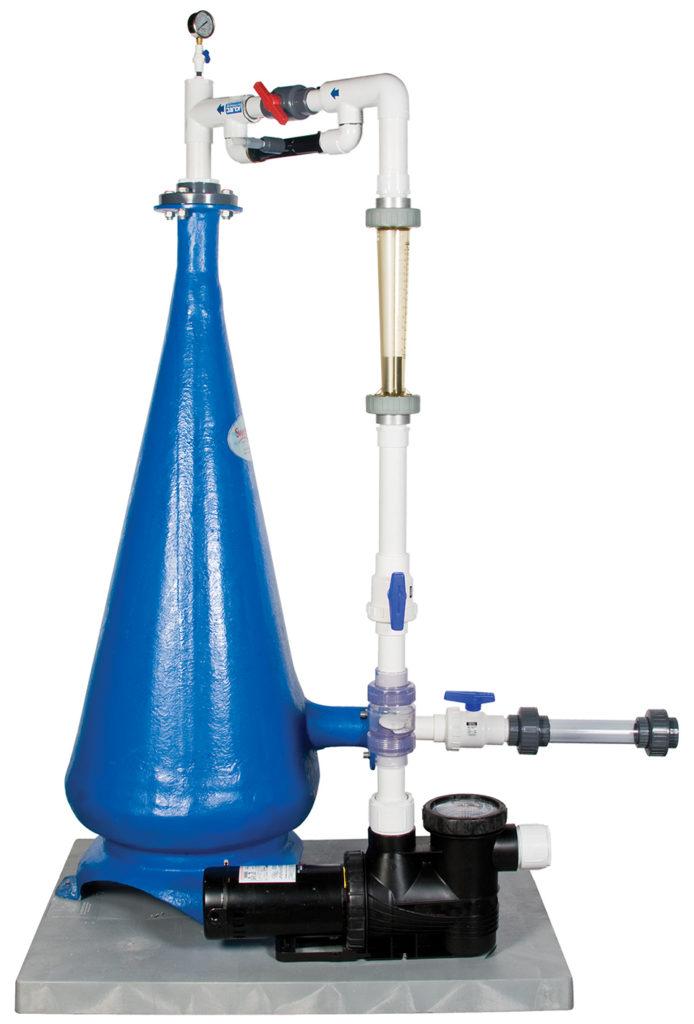
Responsibility
A look at unit processes in RAS systems
The ability to maintain adequate oxygen levels can be a limiting factor in carrying capacities for RAS. The amount of oxygen required is largely dictated by the feed rate and length of time waste solids remain within the systems.
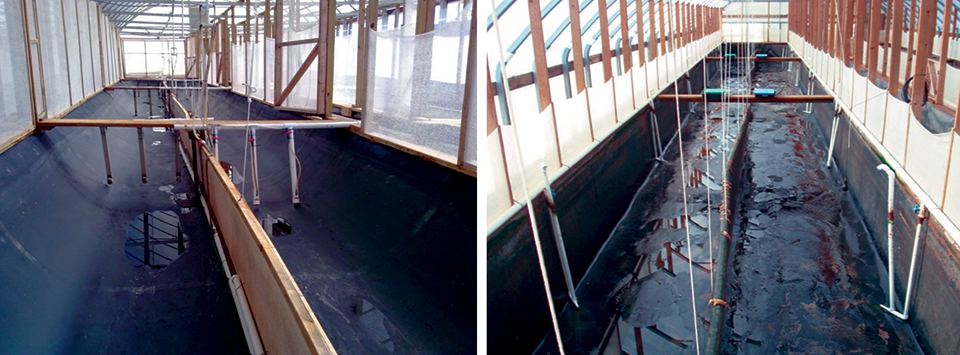
Responsibility
Advances in super-intensive, zero-exchange shrimp raceways
Research at the Texas AgriLife Research Mariculture Laboratory is investigating ways to improve the economic viability of super-intensive raceways for shrimp production.
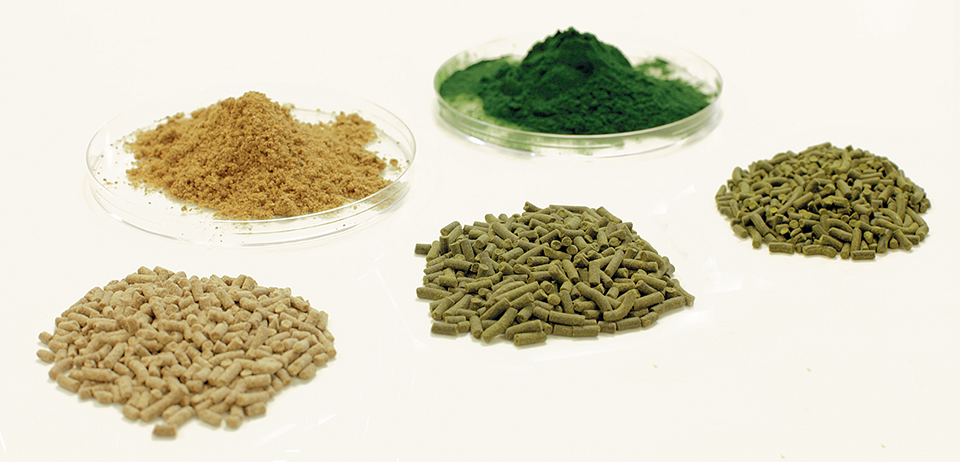
Aquafeeds
Algae alternative: Chlorella studied as protein source in tilapia feeds
Chlorella and other species have potential as protein sources in aquafeeds. In trials with tilapia fry raised in a recirculating system, the fish received a fishmeal-based control diet or feeds with portions of the fishmeal replaced by Chlorella.

Health & Welfare
Ammonia toxicity degrades animal health, growth
Ammonia nitrogen occurs in aquaculture systems as a waste product of protein metabolism by aquatic animals and degradation of organic matter, or in nitrogen fertilizers. Exposure can reduce growth and increase susceptibility to diseases in aquatic species.

